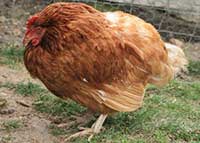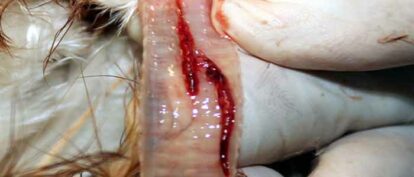There is a misconception that Chlamydia can only be caught by humans from parrots, but it is common in pigeons, occasional in turkeys and ducks and is becoming more common in chickens.
 It is known as psittacosis in parrots or ornithosis in other birds, this is a potentially dangerous zoonotic disease as it may cause flu-like symptoms, pneumonia and abortion in humans.
It is known as psittacosis in parrots or ornithosis in other birds, this is a potentially dangerous zoonotic disease as it may cause flu-like symptoms, pneumonia and abortion in humans.
It is primarily transmitted to humans through the inhalation of infected dust.
Bird keepers need to inform their doctors of their hobby so that in event of illness this disease may be part of the differential diagnosis. Chlamydiosis in sheep (they can be vaccinated) is a reason for pregnant women to stay away in order to prevent transmission of Chlamydia and abortion. Chlamydiosis used to have mandatory control measures which included precautions to prevent the spread of disease including cleaning and disinfection of premises and was one of the factors necessitating quarantine for all imported birds, but as chlamydiosis is readily treatable, this category has recently been removed.
Cause
The organism is Chlamydophila psittaci, more closely related to bacteria than viruses. The strain found in psittacine birds (parrot family) is generally more virulent (acute) than that found in poultry, but in poultry, the low virulence disease can be chronic (long term).
Life cycle
This can only take place in living cells and there is a stage of the life cycle that is within cells before being shed, making detection more difficult. There is also an infectious but dormant stage (elementary body) that can survive in dust for many months.
Transmission
Racing pigeons and feral pigeons are implicated as the main carriers, the incidence of the disease has risen dramatically since the 1980s. Pigeons transmit the disease in crop milk and birds are also infected by contaminated dust and respiratory mucus. Incubation can be as low as 40 days in pigeons to up to 18 months for psittacines. The organism is shed in respiratory mucus and droppings by all infected birds whether acute or chronic and is infective in dust for months. Transmission via the egg does occur but most of these do not hatch.
Symptoms
Signs may be absent (carrier status), mild or severe. Infection in birds can cause purulent (pus-y) ocular and nasal discharge and distressed breathing with a high temperature. Droppings are often green, sometimes containing blood. The appetite is reduced causing weight loss and the bird is lethargic. The eyelids can be swollen and have re-current conjunctivitis. Stress (e.g. overcrowding, transportation, exhibiting) is likely to activate the latent (hidden) disease.
Diagnosis
Not possible from clinical signs. A swab is taken from a suspect bird with acute disease not responding to treatment and tested with ELISA or fluorescent antibody test. The PCR laboratory test (detects chlamydial DNA) is preferred for pooled faeces taken over 3-5 days due to the intermittent shedding of the organism. Some tests can be done immediately within a veterinary practice, either from a blood sample or from a post mortem, and other tests take two weeks for a result. A blood test for identifying carriers that are not shedding the organism is available.
Treatment
No avian vaccine is available. Treatment is with chlortetracycline (in the only source of feed rather than in water) or doxycycline injection or enrofloxacin for six weeks. All birds on the premises should be treated but the risk of the disease re-occurring is always there unless symptomless carriers are identified.
Prevention
Maintain regular disease control plus worming with Flubenvet. Other diseases (e.g. Newcastle, Marek’s, mycoplasma, E.coli) can contribute to the risk of infection as the bird’s immune system is lowered by disease or by stress. Prevent wild pigeons (especially the feral type found in towns) and collared doves from accessing poultry feeders. Ideally, net overruns in susceptible areas. Good general hygiene should be practised. Quarantine any new stock and test them for Chlamydiosis if the rest of the poultry has had the problem to avoid re-infection. Other common similar respiratory problems Mycoplasma is common and respiratory noise with sinus swelling and nasal discharge gets gradually worse. Some of the Chlamydiosis symptoms can lead to treatment for mycoplasma (however, the sweet smell of the nonpurulent nasal discharge indicates mycoplasmosis) but if this treatment does not work, suspect Chlamydiosis and either get pooled faeces or a swab taken. Infectious Bronchitis (IB) is becoming more common. The respiratory stage is over within a few days and then the virus goes into the oviduct, causing shell and albumin problems. The Veterinary Laboratories Agency has identified a “Chinese QX-like virus” in association with the clinical disease of IB in fancy fowl type birds with individual cases to date in, at least, Kent, Dorset, Cornwall, Sussex and Yorkshire. Affected birds can show respiratory or kidney disease. However, if infection occurs in the first few weeks of life it is can be less obvious at the time but result in damage to the oviduct resulting in very poor subsequent production with cystic oviducts. To date, there is no confirmation of its presence in commercial stock. In order to prevent the “blind layer syndrome,” it is advised to vaccinate with MA5 or IB Primer at day old and with IB 4/91 or IB 88 at 14-16 days. Although these vaccines are different from QX it appears that the use of both conventional and variant IB strains early in life provides cross-protection.
Reproduced with kind permission of Fancy Fowl – Text copyright Fancy Fowl 2010. All rights reserved.



